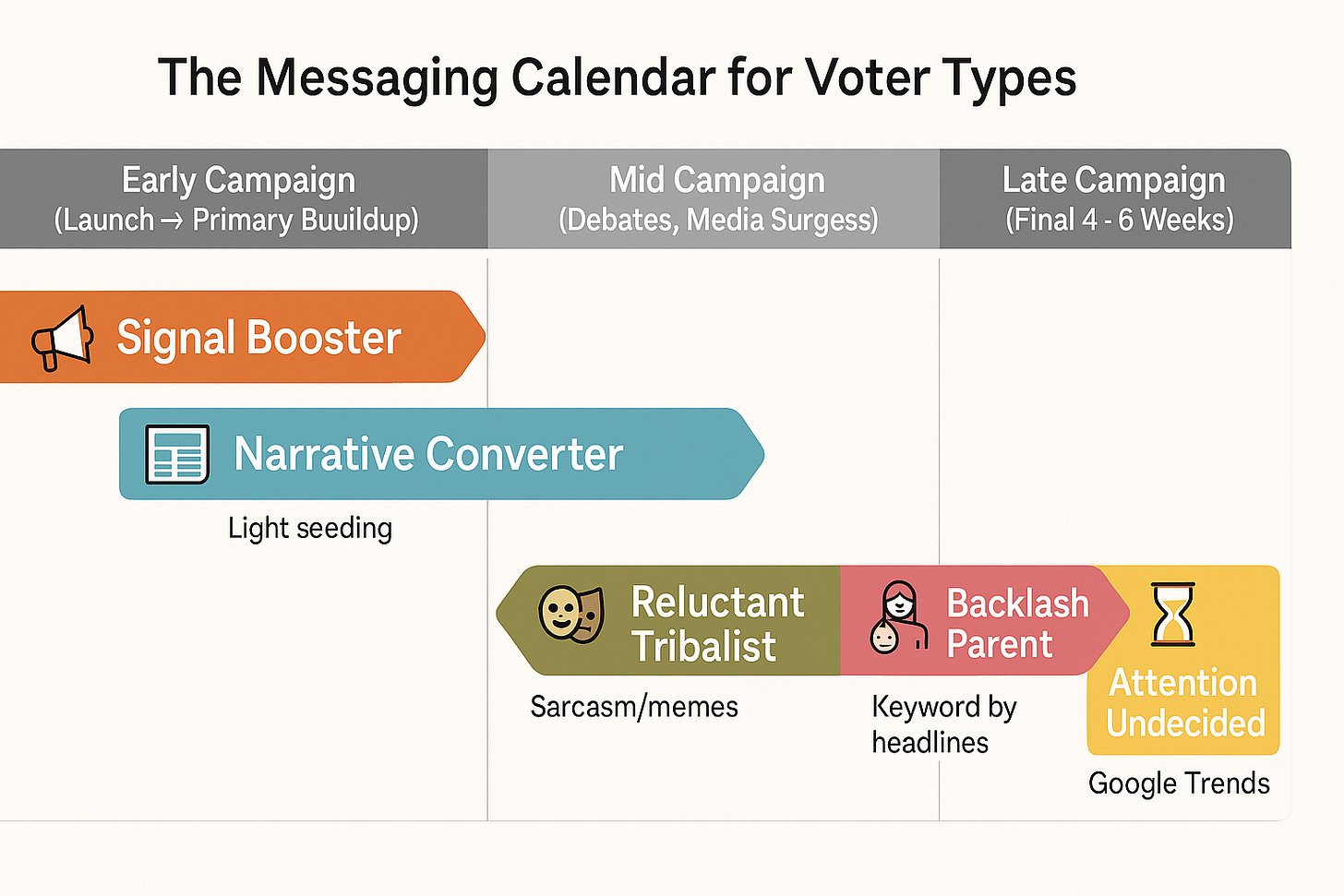How to Operationalize Voter Typology Inside a Modern Campaign (Part 5)
How to make sentiment, polling, and analytics work together in real time
Most campaigns don’t lose because they lack data.
They lose because the data sits in a PowerPoint deck while the field, comms, and digital teams keep running business as usual.
The challenge isn’t knowing that voter sentiment moves before polling. The challenge is building a war room that acts on it.
So today I write about about turning the 7 Voter Types framework into daily campaign discipline—so your team isn’t just observing trends, but actually using them to shape decisions in real time.
Why Campaigns Need a War Room Model
In college football, the best teams don’t just draw plays—the QB adjusts at the line of scrimmage. He calls an audible if the defense shifts.
Campaigns need the same discipline.
Polling = Film study. You know what happened last week.
Analytics = Game plan. You can predict what’s likely to happen.
Sentiment = The defense shifting. You either react in real time—or your QB gets sacked (think Jackson Arnold this season).
Political scientist John Zaller’s Receive-Accept-Sample (RAS) Model (1992) explains: voters don’t instantly internalize every piece of information.
Voters receive signals, accept some, reject others—and only later sample those opinions when asked by pollsters. By the time your pollster calls, the emotional groundwork has already been laid.
Building the War Room Framework
Operationalizing voter typology requires three things:
Dedicated Monitoring
Assign staff (or vendors like EyesOver) to track sentiment across the 7 voter types daily.
Build a dashboard that shows spikes, tone shifts, and keyword movements in real time.
Robert Putnam’s Bowling Alone (2000) shows why this matters: high-social-capital networks (churches, PTAs, community groups) accelerate message diffusion. If you miss the spike in those spaces, you miss the early contagion.
Daily Integration
Every morning, sentiment insights should be matched up with polling summaries and analytics forecasts.
Treat them like weather radar: if the storm is forming, adjust the plan.
The Narrative Velocity Curve: Campaigns must integrate real-time sentiment into daily decision-making.
Lilliana Mason’s Uncivil Agreement (2018) reinforces why—identity cues, not policies, drive behavior. If your base identity group is emotionally shifting, no amount of policy precision will save you if you don’t adapt.
Rapid Response Protocol
Define thresholds for action:
“If Backlash Parents spike on schools, localize messaging within 24 hours.”
“If Signal Boosters fracture, deploy surrogates to reset message discipline.”
The lesson is simple: emotion outruns deliberation. As Neuman et al. (Common Knowledge, 1992) argued, emotion often precedes rational discourse in shaping public opinion.
From Calendar to Daily Ops
Remember the messaging calendar from Part 4? Here’s how it translates inside the war room:
Early Campaign:
Prioritize Signal Boosters → Monitor amplification, discipline tone.
Prep Narrative Converters with storytelling content.
Mid Campaign:
Watch for Cultural Contrarian sparks (overreach moments).
Test Reluctant Tribalist messaging in mail and podcasts.
Late Campaign:
Monitor Backlash Parents for keyword surges (schools, safety).
Watch Silent Resistors via turnout proxies (churches, local orgs).
Hit Attention Undecideds with last-mile persuasion when Google Trends spikes.
Final Takeaway
Campaigns that silo data lose.
Campaigns that operationalize sentiment, polling, and analytics together win.
The war room is where strategy becomes execution. And in 2025/26, it won’t be enough to know who the 7 voter types are. You’ll need to know:
Which one is moving today,
Why, and
What you’re going to do about it before your opponent does.
Coming Next (Part 6):
“The 7 Types Playbook: A Strategist’s Guide to GOP Voter Persuasion.”
This will package the entire series into a field guide you can use—or share with your campaign team.




I've been monitoring for 2 years. I did one year of all statewide primary campaigns in Missouri and select other races and then began signing candidates up and using sentiment/listening to drive message for organic video creation- zero production, all message talking to phone- delivers more than paid. Social is dead. It's all media now.
Really sharp breakdown. The QB audible analogy nails it—polling tells us what happened, analytics forecasts what could happen, but sentiment is the defense moving right now. The real challenge isn’t building dashboards, it’s creating a culture where decision-makers trust that data enough to act on it in real time. Excited to see the 7 Types Playbook.